Anno 1800 review: An Industrial Revolution but not a design revolution - jonessuccart
Bread and circuses. All we need are bread and circuses, to stay fresh the public complacent. And yet, try as I might, I cannot seem to produce enough bread to fulfill the demands of the citizens of Ditchwater. Am I non growing plenty wheat berry? Are the millers not working fast plenty? Do we need more bakeries? Before I can fix the problem it's hit the pages of the local anaesthetic newspaper publisher, further stoking resentment. A riot breaks out, protesters clashing in the streets with my lilliputian police force.
Simultaneously, a thousand miles away and across the ocean, arsonists are attempting to burn my fledgling settlement on La Isla. Chances are they're kindred to the same wraithlike radical that murdered my father and stole my inheritance—simply I give the sack't stop them, because I assume't even let enough bricks to human body a police station here.
Everything's going wrong at once, and it's all my fault. That'sAnno 1800.
Times are a changin'
Later twoAnno experiments set in the distributed proximo, the series returns to its roots as a historical city-builder-slash-strategy gimpy withAnno 1800. Arsenic old fans can without doubt surmise from the title, the game is kick in the 1800s, the stop of the industrial revolution, with distinctly Victorian ERA architecture and a focus along factory labor.
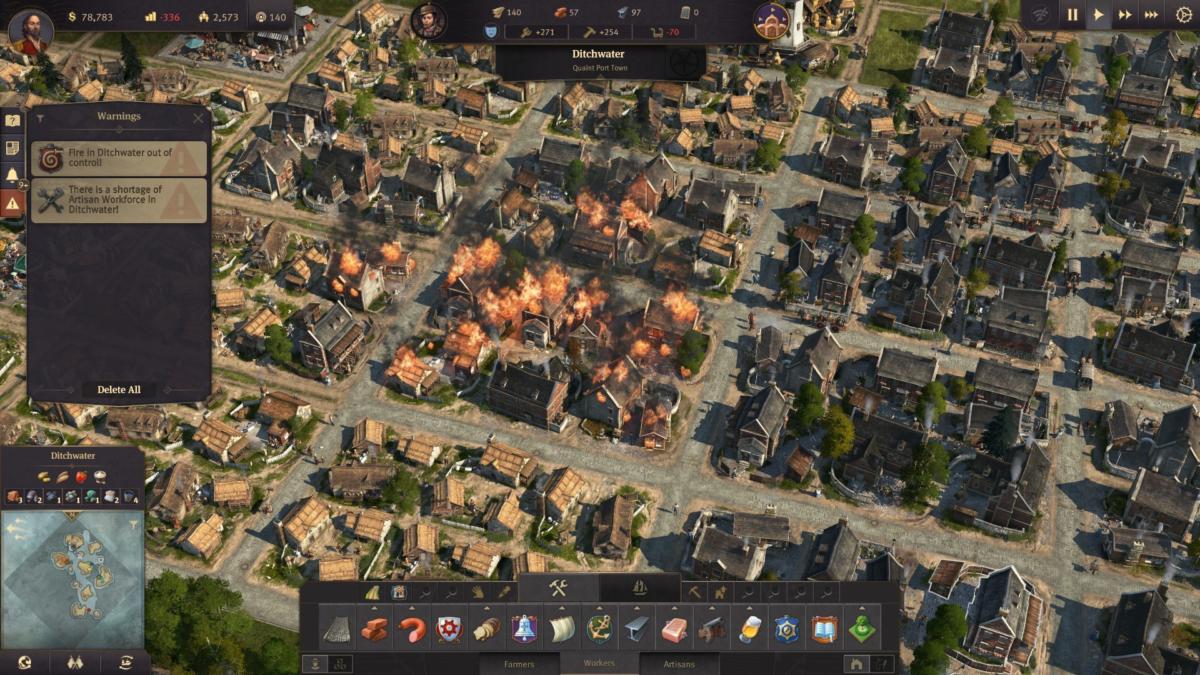 IDG / Hayden Dingman
IDG / Hayden Dingman And if you look-alikeAnno, it still does theAnnothing bad damn substantially—which is to say, IT's a bet on about optimization. Sure, itlooks like a city builder, but it's more complicated than your averageSimCityorCities: Skylines. Money isn't your only constraint, Beaver State even your primary constraint. As an alternative you are balancing a bunch of resources against the needs of your citizens, or at to the lowest degree attempting to do so.
IT starts out relatively easy. You demand farmers, which means you motive houses for the farmers, which means you need lumber. Fifty-fifty this is a two-step process though. To get lumber, you'll need to bring off the "Lumber Production Chain," offse building a lumberjack's field hut to supply logs, then supplementing with a sawmill to turn the logs into usable boards to create houses.
Now you deliver farmers—but the work doesn't stop on that point. The farmers have needs likewise, sol you build a dock for sportfishing boats, create a potato farm and a still, create pens for sheep and a factory to turn the fleece into yarn and so uncomplete clothes. All of these require labor, which means more houses, which means more farmers, which means more potato farms and sheep pens and factories, and sol on.
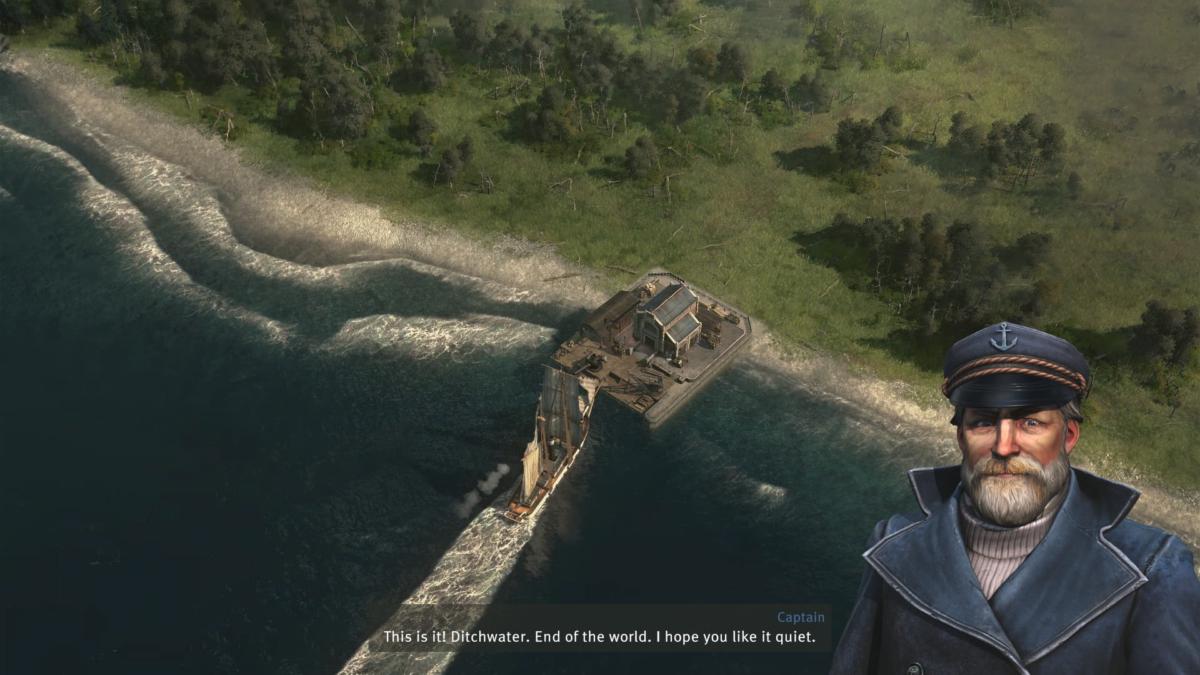 IDG / Hayden Dingman
IDG / Hayden Dingman This is theAnno loop, and information technology exclusively gets more complex from there. Finally you'll turn some of those farmers into workers, and then into artisans, each with different necessities you need to cater—transcribed food, sewing machines, sausages, and then on. And so when it seems like it couldn't possibly get Thomas More complicated,Anno 1800 introduces the Hemisphere, a second metropolis that runs parallel to the first and turns impermissible products like rum and coffee that your laborers in the Old World deprivation to leverage. Get ready to set awake approximately trade routes.
It'll be very familiar toAnno veterans, especially those World Health Organization were around the parting timeAnno was set in a historical period. Many of these ideas are throwbacks to the colonialAnno 1701and the like, just moved forward to the Victorian Era. The main differences are some upper-class-of-life changes made in the future-eraAnnos that now map onto1800, plus one key new "blueprinting" have that I'm really lovesome of.
Most important, in my opinion, is the Move feature. This was introduced inAnno 2205, and allows you to easily reorganize your cities aside picking rising any structure and rolling it to a parvenue area. OnAnno's standard difficulty you can get along this at any moment and to whatsoever structure, for give up. Realistic? Atomic number 102, but IT's a welcome addition that helps solve the standard city-constructor problem where starting taboo you build a sawmill or a wheat grow in what in time becomes the center of your town. Immediately you simply pick that sawmill dormy and move it to the outskirts again, where it belongs.
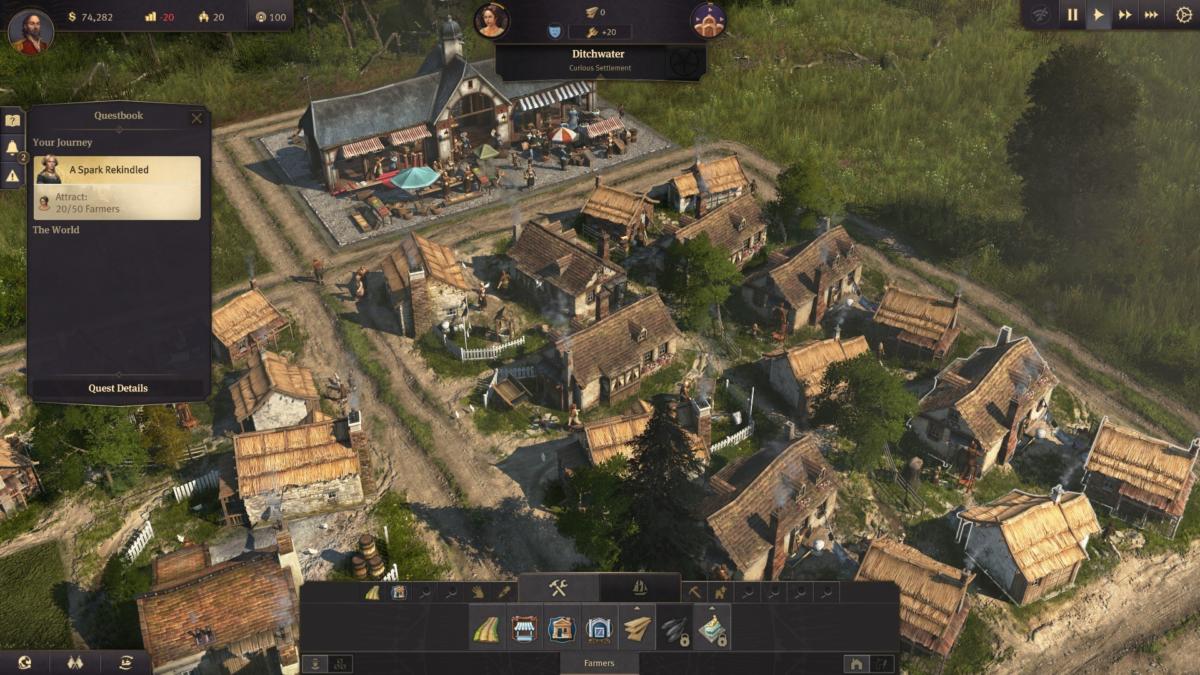 IDG / Hayden Dingman
IDG / Hayden Dingman Anno 1800 also adds another feature to help budding urban planners: Blueprint Mode. Say you have a go at it you want to reserve a plot for your Town Entrance hall but your factories haven't produced enough Windows yet, you can now place a silhouette of the Town Hall onto the spot in question. These blueprints South Korean won't function until you human body them properly, but it's a nice touch for people who same to neatly represent their cities.
Unfortunately,Anno 1800 feels like a step back in some regards fromAnno 2205. I really loved that the trey environments in2205 felt varying along a minute-to-little floor. The light zones played wish a standard metropolis detergent builder, but the arctic areas affected you to cluster houses around factories for heat, and the late-game lunar colonies were limited by expensive equipment domes.
Anno 1800 doesn't have that luxuriousness, limited as information technology is by the scope of the Victorian Earned run average. Aside from the unique resources, building in either zone feels interchangeable. Islands tend to be smaller in the Hemisphere, but you're not really forced to see with tropical storms or anything that mightiness fundamentally change how you play a city detergent builder. I remember in that respect might cost a slight tendency towards more diseases in the New World, but this is easily resolved by the fact you unlock hospitals earlier than your Old World counterparts.
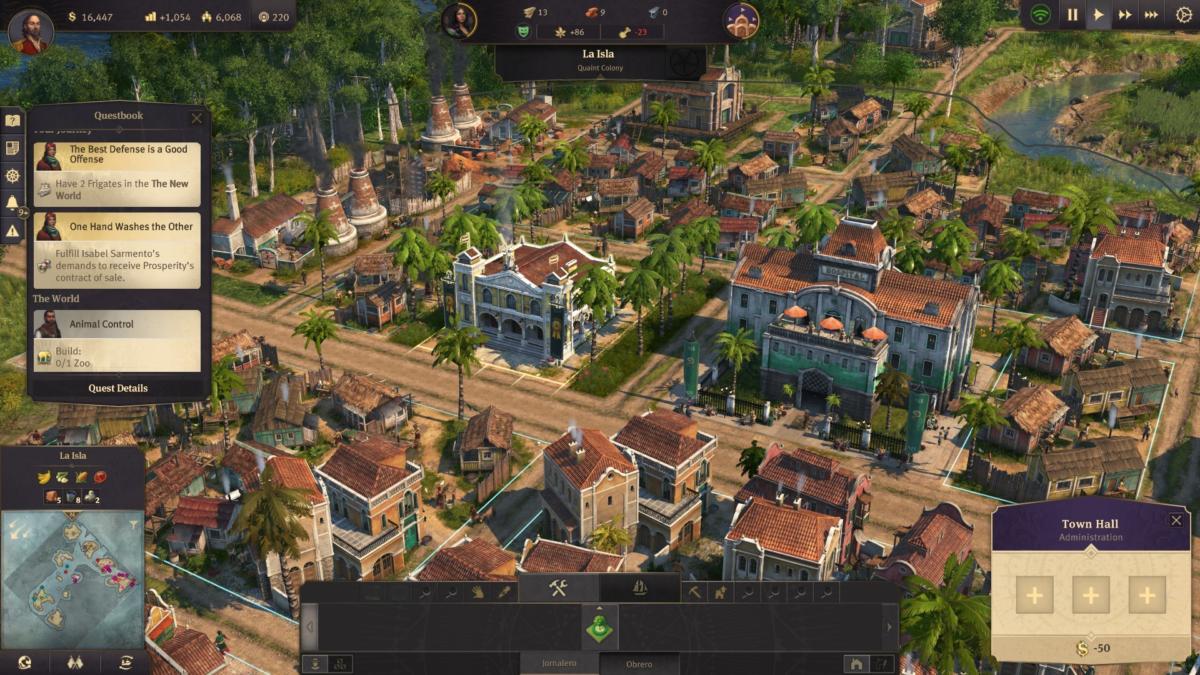 IDG / Hayden Dingman
IDG / Hayden Dingman And the hardest set out ofAnno is still calculation out what the hell is going wrong. I complained roughly the interface inAnno 2205, which pared down the doddering schoolbook-heavy menus into something more pleasing to the eye.1800 is a weird cross though, in this the menus are more cluttered than they were in2205 but still don't tell the actor enough.
Try figuring outer why you can't upgrade your old husbandman hovels into gleam worker apartments, for instance. To do so you'll need to click happening one of the farmer residences and see what you'rhenium short on—let's say worker apparel. Then you'll need to figure out which arrange of vesture product is the bottleneck. Do you not wealthy person enough sheep farms? Not enough thread? Beaver State just not enough vesture factories?
And at that place's non in truth an elegant way to grade-constructed this information either. You can pore over your warehouse's storage list to see if thither's an obvious shortfall in one or another product, but I often found information technology easier to find the factories relevant and check in small stages whether from each one process had access to enough underdone materials. "Easier." The problem's compounded any time trade comes into the equation, trying to figure out whether you're come out of cotton or hops or what-have-you because nobody can sell you more or if there's a gravy boat on the direction oppressed with the resources you need.
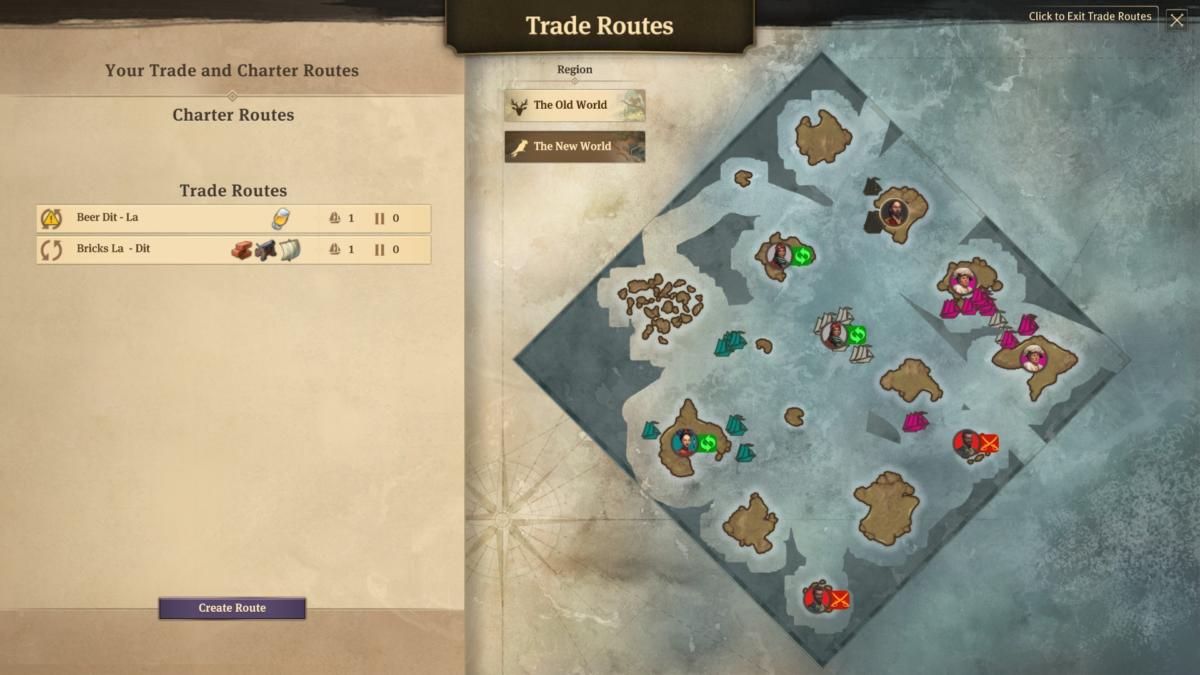 IDG / Hayden Dingman
IDG / Hayden Dingman Information technology just feels infelicitous at times.Anno is fundamentally a series about micromanaging. Reviewing2205, I wrote thatAnno "often feels less like [building a] real city and much like machinery." It's all about managing pipelines, spinning cardinal-cardinal plates at at one time and all those plates have additional plates balanced along top. And ifAnno has a flaw, information technology's that it's terrible at cogent you when one of the plates starts to wobble.
Hunky-dory, nonpareil more flaw: It's a game about colonialism, but it's unintentional to engage with what that historically entailed. I'm not really indisputable what I await a city builder to do in this regard, but information technology's cardinal of the thornier parts ofAnno 1800 that the series avoided with the future-orienting2070 and2205. The history of colonialism in South America is barbarous, exploiting both the region's rude resources and push on pool.Anno has you building sugar plantations, stripping the land of gold and oil, et cetera, and doesn't ever ask the player to think double nearly the ramifications.
It's scarce the first-class honours degree long-spurting serial to come across this issue.RefinementandEuropa Universalis, for example, accept run afoul of the synoptical trouble in recent long time as developers and players both try to align the modern (more often than not negative) connotations of colonialism with games predicated on colonialist ideas. I found myself thinking about it a lot playactingAnno 1800 though, watching my Sombrero-clad workers toiling on the sugarcane plantation without seemingly a care in the world.
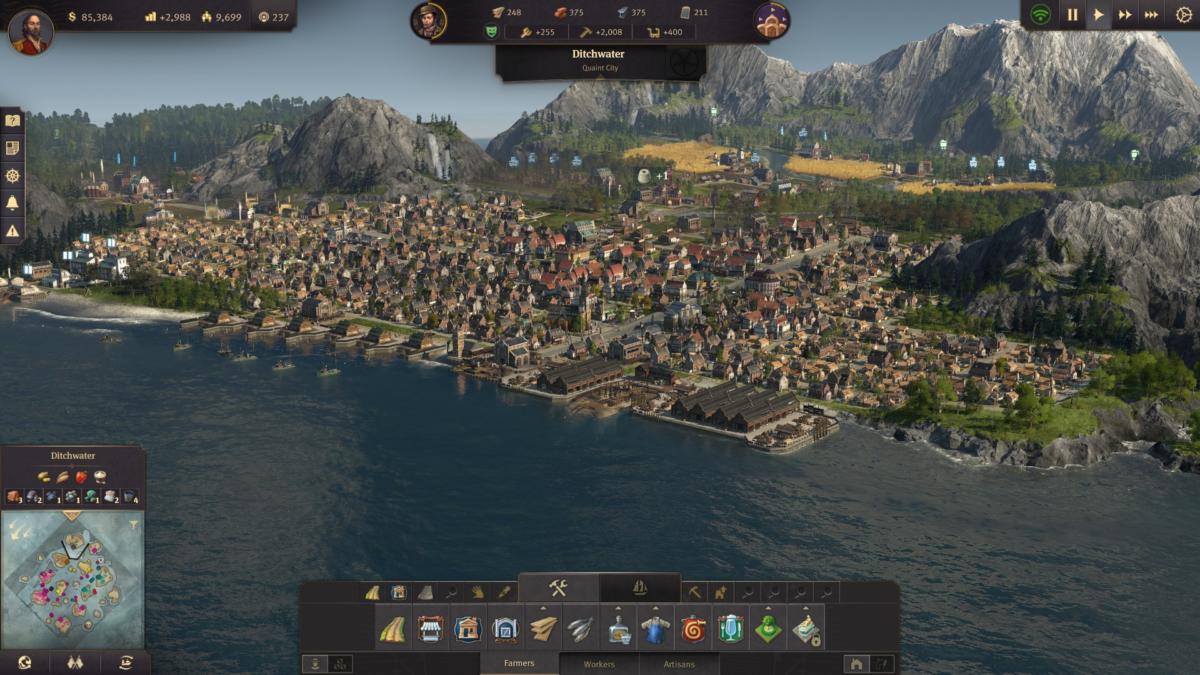 IDG / Hayden Dingman
IDG / Hayden Dingman To its recognition,Anno 1800 does try to grapple with industrial enterprise's impact on the populace, with every factory you add decreasing your city's attractiveness rating. This organization's pretty lanky though, with penalties applied to entire islands instead of (As inCities: Skylines) affecting the immediate area close to an industrial center. There also aren't, from what I've seen, any impacts on the land or the masses themselves. You can place a wheat field next to a fume-spewing mill with no negative bear on, and none of my citizens always came pop with respiratory problems or anything despite living in the shadow of the smokestacks.
That said, this is the virtually impressed I've been with anAnno game on a technical level. The buildings are incredibly elaborated, behind to signs and heaving bits of machinery. The streets bustle with people. Sheep thread approximately their pens. Musa paradisiaca trees wave in the flatus. Your island is only one of galore, atomic number 3 the map is populated by a bunch of Artificial insemination island-cities as well, some of which (in the crusade leastways) are vastly large than your own.
 IDG / Hayden Dingman
IDG / Hayden Dingman And then at that place's the New Worl/Old Globe dynamic. Both run at the same prison term and can be switched between happening-the-fly—andlike a sho. In2205 I complained that switching zones compulsory a 20-second load each time, but inAnno 1800 you rear toggle Region to New World and in reply again with zero freight screens.
It's incredible, really. I'm running on an Intel Core i7-5820K and an Nvidia GeForce GTX 1080 Ti and nonetheless I've seen a morsel of slowdown, but frankly with this much occurrence at once I'm amazed it runs at every.
Can line
As e'er,Anno 1800 is blemished but oddly engrossing. I've fatigued 15 or 20 hours constructing my little ocean-spanning empire now, and may well spend 15 or 20 more fleshing it out. Much as I miss the additive challenges posed by the environments in2205, there's nonetheless a satisfying loop toAnno 1800 that makes it one of the more unique city-builders, balancing two-twelve different resources, patronage, diplomacy, and a rudimentary USN complete simultaneously.
I'd like to see Blue Byte better the framework next time though, the structure within which that iteration is controlled. The menus need a complete overhaul for starters—even the non-game menus. It took ME 10-plus hours to find knocked out you tail end splay buildings by clicking the middle sneak out button because it's not even registered in the settings carte du jour. It's only detailed in a consignment screen tip, and the only time you see load screens is on first inauguration.
Bigger picture, I'd like to catch a more dare setting next metre as well. Anno 1800 returns the series to its roots after two games away, which is pure, merely IT does feel like performin it safe aft the creatively daring2070 and2205.It'd be bang-up to see some other departure presently—enunciat, anAnno leading the Phoenicians or another ancient trade Empire.
ButAnno 1800 will do for now. It's nonentity we haven't seen ahead, and it's a bit leprose some the edges, butAnno's quieten the most entertaining you can have with a glorified spreadsheet. Just be destined to build dozens of bakeries.
Source: https://www.pcworld.com/article/403544/anno-1800-review.html
Posted by: jonessuccart.blogspot.com


0 Response to "Anno 1800 review: An Industrial Revolution but not a design revolution - jonessuccart"
Post a Comment